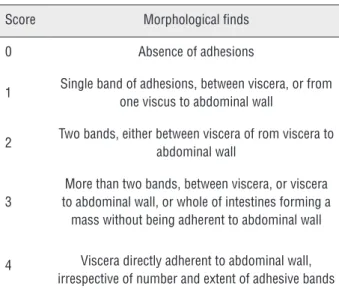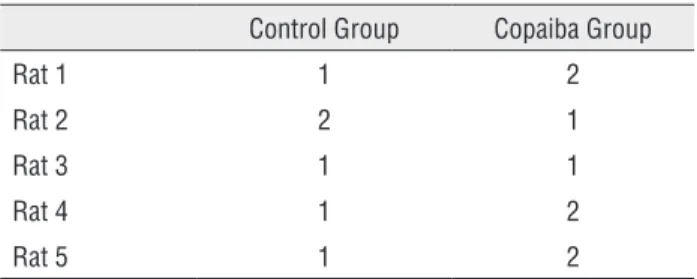384
Effects of Copaiba oil in the healing process of urinary
bladder in rats
_______________________________________________
Denilson José Silva Feitosa Junior
1, Luan Teles Ferreira de Carvalho
1, Ingrid Rodrigues de Oliveira Rocha
1,
Camila Noura de Brito
1, Rodrigo Alencar Moreira
2, Charles Alberto Villacorta de Barros
31 Laboratório de Cirurgia Experimental, Universidade Estadual do Pará, Belém, PA, Brasil; 2 Departamento de Pesquisa Cirúrgica e Experimental, Universidade Estadual do Pará, Belém, PA, Brasil; 3 Departamento de Cirurgia Experimental e Anestesiologia, Universidade Estadual do Pará, Belém, PA, Brasil
ABSTRACT
ARTICLE
INFO
______________________________________________________________ ______________________
Introduction: The appropriate closure of the urinary bladder is important to many uro-logic procedures to avoid the formation of fistulas and strictures by excessive fibrosis. This paper presents the alterations in the bladder healing process of rats after the topi-cal use of Copaiba oil (Copaifera reticulata).
Material and Methods: Ten male Wistar rats were used and randomly divided into two groups: Control group (CG): injected 1ml/kg of saline solution on the suture line; and Copaiba group (CpG): 0.63ml/kg of copaiba oil applied to the suture line. Euthanasia was performed on the seventh day after surgery. The criteria observed were adherences formation, histopathological modifications and stereology for collagen.
Results: Both groups showed adhesions to the bladder, with no statistically significant difference (p=0.1481). The microscopic evaluation revealed a trend to more severe acute inflammation process on the CpG, but there was statistical difference only in the giant cells reaction (p=0.0472) and vascular proliferation (p=0.0472). The stereology showed no difference.
Conclusion: The copaiba oil modified the healing process, improving the quantity of giant cells and vascular proliferation, but not interfered in the collagen physiology.
INTRODUCTION
The appropriate closure of the urinary bla-dder is important to many urologic procedures to avoid the formation of fistulas and strictures by excessive fibrosis (1). Although healing occurs si-milarly in different tissues, some organs have their peculiarities. In the case of the urinary bladder,
scarring may be impaired by the presence of uri-ne (2). Although when compared with healing of the intestines, the bladder has a faster healing rate and tensile strength gain (3).
Regenerative medicine has been trying alternatives to common suture threads to
impro-ve the rapid regeneration of the bladder, such as adhesives and barbed sutures (4). In addition, the use of medicinal plants in bladder healing has shown interesting results in experimental research (5, 6).
The copaiba oil (Copaifera sp.) is a native Amazonic herb and has many proprieties descri-bed such as anti-inflammatory, antibiotic, wound healing and anti-neoplastic (7). The majority of these were already scientifically described in ex-perimental and clinical research, but none of that research tested this oil on the bladder healing process. To develop knowledge about the poten-tial benefits of this plant, we evaluated the use
Keywords:
Urinary Bladder; Wound Healing; Plants, Medicinal; Collagen
Int Braz J Urol. 2017; 43: 384-9
_____________________
Submitted for publication: March 09, 2017
_____________________
Accepted after revision: June 08, 2017
_____________________
of copaiba oil in the healing process of the uri-nary bladder in rats by macro- and microscopic analysis, regarding the formation of adherences, histopathological characteristics and stereology for collagen. This paper presents the alterations on the infl ammatory response and collagens physiology in the bladder healing process of rats after the to-pical use of copaiba oil (Copaifera reticulata).
MATERIAL AND METHODS
Animals
Ten male Wistar rats (Rattus norvegicus), weighing between 200g and 250g, were used in this study. The animals were housed in steel ca-ges, cleaned twice a week, and put in a control-led environment with a temperature of 22±2ºC, with adequate humidity and artifi cial light in a photoperiod of 12/12 hours. Water and food were offered ad libitum throughout the study. The ex-perimental procedures started only after the ap-proval of this research by the Ethics Committee in Animal’s Use from the Pará State University by the protocol 25/2015.
Experimental design
Rats were randomly divided into two groups, with fi ve animals each. Groups were esta-blished as follows: Control group (cystotomy was
performed followed by suture and the injection of 1mg/kg of saline solution directly on the suture. N: 5) and Copaiba group (cystotomy was perfor-med followed by suture and the injection of 1mg/ kg of copaiba oil directly on the suture. N: 5).
Copaiba oil
The Copaiba Oil was obtained commer-cially from Amazon Oil©. The oil was extracted in
the city of Itaituba, Brazil and was certifi ed by a chemical engineer. Its composition was 45% of
β-caryophyllene.
Surgery procedure
The animals were anesthetized by intra-peritoneal injection of ketamine (70mg/kg) and xylazine (10mg/kg). Then, the rats were put in su-pine position on a surgical board. The trichotomy and antisepsis of the lower third of the abdomi-nal region were performed and a median incision of 2cm made to expose the bladder (Figure-1A). Then, an 1cm cystotomy was performed and su-tured with 4-0 Polydioxanone - PDS© (Figure-1B). For the cystotomy instead of incising the serosa, muscular and mucosa at one time, we divided this step into two stages, reserving an incision only for the mucosa. Immediately following, either the sa-line solution or copaiba oil were injected,
depen-Figure 1 – Urinary bladder before (A) and after the cystotomy and suture with PDS© (B).
386
ding on the group. Then, all the animals had their abdominal wall closed with 4-0 nylon in conti-nuous suture for the muscle-aponeurotic plane and separated for the skin.
Macroscopic analysis
On the seventh day after surgery, the rats were euthanized by an overdose of halothane by inhalation. Then, the macroscopic analysis began with inspection of the abdominal scar and verifi-cation of presence or absence of infection in the cavity. With the abdominal wall opened, we pro-ceeded to evaluate adhesion formation, using the Nair score (8) (Table-1).
Microscopic analysis
After total cystectomy, the bladder was fi-xed in 10% formalin by 48h and the suture threa-ds were removed. The piece was cleaved into three parts, contemplating the border, center and inci-sion of the bladder. The tissues were dehydrated, diaphanized in xylol and parafinized. Then, the tissues were cut into 5µm sections at 250µm inter-vals, mounted on slides and stained with hemato-xylin/eosin and Masson’s trichrome stains.
The criteria observed were acute in-flammation, necrosis, foreign-body giant cell reaction, re-epithelialization and vascular pro-liferation in hematoxylin/eosin stain.
Fibro-blast and collagen growth was estimated in the Masson’s trichrome stain. Each item was gra-ded from 1 to 4, as follows: 1- absent; 2- mild; 3- moderate; 4- intense.
Stereology
Five sections stained with Masson’s tri-chrome were randomly analyzed from each bla-dder. In each section, five fields were analyzed, totaling 15 fields per bladder. The analyzed fields were digitized to a final magnification of x100 using a video camera coupled to a light microscope.
The volumetric density of the collagen fibers and muscle fibers in the muscular layer was analyzed by overlaying the M-42 grid sys-tem on the computed morphological image of the slides. The volumetric density was the re-lative density taken up by fibers in the tissue under examination. The stereological method determined quantitatively the parameters of the anatomical structural based on the two-dimen-sional thin sections, in three dimensions.
The equation Vv= ____PsPp x100% was used to calculate the volume density of the collagen fibers, where: Vv=volumetric density, Ps=the number of structure points studied (collagen) and Pp=the number of possible test points (42 in this case).
Statistical analysis
The statistical analysis was made in the software Bioestat© 5.3. The Mann-Whitney test was used, with p <0.05 as the criterion for sig-nificance for all statistical comparisons.
RESULTS
Macroscopic analysis
There was no infection on the abdomi-nal surgical wound in either group. In both the control and copaiba groups, we observed adhe-sion to the bladder with the omentum and the abdominal wall, with no statistically significant difference (p=0.1481). The categories of adhe-sions following the Nair Score found in each group are described in Table-2.
Table 1 - Nair score (Nair; Bath and Aurora, 1974).
Score Morphological finds
0 Absence of adhesions
1 Single band of adhesions, between viscera, or from one viscus to abdominal wall
2 Two bands, either between viscera of rom viscera to abdominal wall
3
More than two bands, between viscera, or viscera to abdominal wall, or whole of intestines forming a
mass without being adherent to abdominal wall
Microscopic analysis
From the histopathological parameters analyzed, the only differences identifi ed between the groups were the giant cells reaction (p=0.0472) and vascular proliferation (p=0.472) (Figure-2). The statistical analysis of histological parameters, as well as the p value for each variable, is summa-rized in Table-3.
Stereology
In the histological sections, we observed no differences between the groups (p=0.615) (Fi-gure-3). The fi bers volumetric density in both groups is listed on Table-4.
DISCUSSION
The search for ways to improve the hea-ling process and reduce its side effects dates to the
Hippocratic era; at present, there is no therapeutic method to fully control the harmful effects of the wound healing process. The search for new drugs should be encouraged for better control of wound infl ammation, which in many cases causes surgi-cal complications.
We know that the use of copaiba in the pe-ritoneal cavity forms adherences because copaiba oil has a corrosive effect (9). However, there was no difference between the groups regarding the formation of adherences. This data disagree with other study that used copaiba oil directly on the peritoneal cavity, which caused the copaiba group to develop greater adherences (10). This probably occurred because the dosage of copaiba oil in our study was lower and concentrated in the bladder.
Regarding the microscopic analysis, the copaiba oil modifi ed the healing process when compared with saline solution. The copaiba group showed statistically different results in the quan-tity of giant cells and vascular proliferation. The giant cells are activated macrophages which play an important role in modulating the infl ammation process, performing down-regulation and protec-ting the tissue (11).
On the other hand, the higher vascular proliferation reinforces the idea that copaiba in-creases local infl ammation, since the factors for vascular proliferation are mainly released by ac-tivated macrophages (12). Those data suggest that the topical administration of copaiba oil may have
Table 2 - Categories of adhesion according the Nair score in both groups.
Control Group Copaiba Group
Rat 1 1 2
Rat 2 2 1
Rat 3 1 1
Rat 4 1 2
Rat 5 1 2
Mann-Whitney test, p=0.1481
Figure 2 – Histopathological slide of a rat urinary bladder from both the control (A) and copaiba (B) group. Note the vascular congestion and proliferation (black arrows) and the giant cell reaction (red arrow). Hematoxylin/Eosin stain 20x.
388
Table 3 - Statistical analysis of histological parameters by the Mann-Whitney test with the rank-sums of which group and the p value.
Histological variables Control Group rank-sum Copaiba group rank-sum p
Acute inflammation 20.5 34.5 0.143
Necrosis 22.5 32.5 0.296
Giant cells reaction 18 37 0.047*
Fibroblasts 25 30 0.601
Collagen 30 25 0.601
Re-epithelialization 23 32 0.347
Vascular proliferation 18 37 0.047*
*significant statistical difference
Figure 3 – Histopathological slide of a rat urinary bladder from both the control (A) and copaiba (B) group. Note the collagen fibers (black arrow) and the vascular proliferation (red arrows). Masson's trichrome stain 20x.
B A
Table 4 - Volumetric density in percentage (Vv%) of collagen in the bladder of control and copaiba groups.
Control Group Copaiba Group
Mean 39 41
Standard deviation 6.38 6.34
Standard error 2.85 2.83
Minimum 29 31
Maximum 43 49
enhanced the inflammation due to its corrosive nature, which increased the inflammatory phase of healing and delayed the beginning of the proli-ferative phase.
The results might be different if the co-paiba oil was administrated by gavage. Yaso-jima et al. (13) showed that the oral adminis-tration of copaiba modulates the inflammatory response and improves wound healing in abdo-minal wall defects.
In relation to the amount of collagen fi-bers, other studies showed that copaiba oil may improve the organization of those fibers in bone regeneration when topically applied, which was not observed in our results (14). Besides having a trending to have more collagen than the control group, there was not statistical difference in the total amount, as well as occurred in the quantity of fibroblasts. Then, in this study the copaiba oil did not enhance healing.
CONCLUSIONS
We conclude that the copaiba oil modi-fied the healing process improving the quantity of giant cells and vascular proliferation, but not interfered in the collagen physiology.
CONFLICT OF INTEREST
None declared.
REFERENCES
1. Ninan N, Thomas S, Grohens Y. Wound healing in urology. Adv Drug Deliv Rev. 2015;82-83:93-105.
2. Holmes SA, James M, Whitfield HN. Potential use of tissue adhesive in urinary tract surgery. Br J Urol. 1992;69:647-50. 3. Hildreth BE 3rd, Ellison GW, Roberts JF, Adin CA, Holloway
TJ, Archer LL, et al. Biomechanical and histologic comparison of single-layer continuous Cushing and simple continuous appositional cystotomy closure by use of poliglecaprone 25 in rats with experimentally induced inflammation of the urinary bladder. Am J Vet Res. 2006;67:686-92.
4. Petrut B, Hogea M, Fetica B, Kozan A, Feflea D, Sererman G, et al. In-vivo assessment of barbed suturing thread with regard to tissue reaction and material absorption in a rat model. Clujul Med. 2013;86:371-6.
5. Gonçalves Filho A, Torres OJ, Campos AC, Tâmbara Filho R, Rocha LC, Thiede A, et al. Effect of Passiflora edulis (passion fruit) extract on rats’ bladder wound healing: morphological study. Acta Cir Bras. 2006;21(Suppl 2):1-8.
6. Lucena PL, Ribas Filho JM, Mazza M, Czeczko NG, Dietz UA, Correa Neto MA, et al. Evaluation of the aroreira (Schinus terebinthifolius Raddi) in the healing process of surgical incision in the bladder of rats. Acta Cir Bras. 2006;21(Suppl 2):46-51.
7. Pieri F, Mussi M, Moreira M. Copaiba oil (Copaifera sp.): history, extraction, industrial applications and medicinal properties. Revista Brasileira de Plantas Medicinais. 2009;11:465-72.
8. Nair SK, Bhat IK, Aurora AL. Role of proteolytic enzyme in the prevention of postoperative intraperitoneal adhesions. Arch Surg. 1974;108:849-53.
9. Silva NSR, Santos CF, Gonçalves LKS, Braga FS, Almeida JR, Lima CS, et al. Molecular Modeling of the Major Compounds of Sesquiterpenes Class in Copaiba Oil-resin. British Journal of Pharmaceutical Research. 7(4):247-263.
10. Yasojima EY, Teixeira RKC, Houat AP, Costa FLS, Yamaki VN, Feitosa-Junior DJS, et al. Copaiba oil influences ventral hernia repair with Vicryl® mesh? ABCD Arquivos Brasileiros de Cirurgia Digestiva (São Paulo). 2015;28:186-9.
11. Fujiwara N, Kobayashi K. Macrophages in inflammation. Curr Drug Targets Inflamm Allergy. 2005;4:281-6.
12. Koh TJ, DiPietro LA. Inflammation and wound healing: the role of the macrophage. Expert Rev Mol Med. 2011;13:e23. 13. Yasojima EY, Teixeira RK, Houat Ade P, Costa FL, Silveira
EL, Brito MV, et al. Effect of copaiba oil on correction of abdominal wall defect treated with the use of polypropylene/ polyglecaprone mesh. Acta Cir Bras. 2013;28:131-5. 14. Dias-da-Silva MA, Pereira AC, Marin MC, Salgado MA. The
influence of topic and systemic administration of copaiba oil on the alveolar wound healing after tooth extraction in rats. J Clin Exp Dent. 2013;5:e169-73.
_______________________ Correspondence address:



